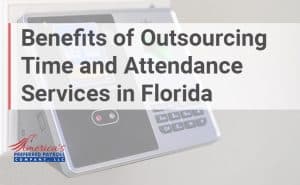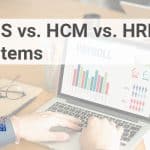There are many acronyms in the human resources management technology industry, but what exactly is an HRIS system? What are HCM platforms? These and other HR-related acronyms can be confusing and lead to indecision if they’re not defined and differentiated.
In this blog post, we’ll compare the HRIS, HRMS, and HCM software categories, so you can be in a better position to make an informed decision on which type of HR software to purchase. Learn more by reading on!
HR Software Categories
As you may have realized, your payroll and HR provider may be unable (or unwilling) to assist you with making a wise choice of HR software. After all, they don’t want your dependence on them to be reduced or eliminated. Also, it’s possible that your company’s existing HR practices may be hopelessly dated.
Although the terms HRIS and HCM are often used interchangeably in terms of HR technology, we can tell you more about what each solution should offer. Below, we’ll examine HRIS vs. HRMS systems and compare them to a third option, HCM systems. By doing so, we can help to ensure that your future investment in HR software will be a cutting-edge solution tailored to your organization’s specific needs.
What’s HRIS Software?
A Human Resource Information System (HRIS) stores employee information necessary for standard HR tasks. Without an HRIS, HR employees are stuck using paper records and spreadsheets. Inaccuracies, misplaced paperwork, and inconsistencies are all possible outcomes of such manual data entry and storage.
By contrast, names, residences, SSNs, work permits, and dependent information can all be easily and rapidly updated using HRIS tools. Reports on HR metrics and employee information can be pulled from specific HRIS systems for more strategic resource management. Self-service options for employees can improve the efficiency, speed, and flexibility of HR processes.
In most cases, HRIS systems provide:
- Payroll and tax compliance, including the calculation of pay after the deduction of applicable taxes and benefits
- Time and attendance recording, including working hours, paid time off, and staff schedules
- Online enrollment, data management, and regulation tracking for employee benefits
- The ability to keep tabs on staff members by having them update their contact, job, and personal details in one central online directory
- Self-service, by allowing workers to enroll in benefits, see their accrued balances, and change their personal information all on their own via self-service options (it should be noted that employees become more invested in their job when they’re given more responsibility)
What’s HRMS Software?
Managing human resources efficiently can boost business productivity. In order to maximize employee performance, an HR department requires a means of monitoring and understanding its staff.
A Human Resource Management System (HRMS) tracks processes related to managing employees during their employment lifecycles, whereas HRIS manages employees’ personnel records. HRMS information can help company management gain insights into recent trends in their workplace and how they can affect their business.
Some examples of HRMS functions are:
- Managing performance by establishing goals and measuring employee progress toward these goals
- Advertising open roles, collecting resumés online, and keeping track of potential candidates
- Reducing time spent onboarding by automating paperwork and keeping tabs on training
- Generating reports by analyzing business trends and delivering insights management can use
Similarly to HRISes, HRMSes have the potential to increase engagement during the hiring process. An HRMS is different, however, because it allows businesses to keep their employees engaged via the use of personalized objectives and regular performance reviews.
Why should performance reviews play a role in choosing between an HRMS or HRIS? Over time, more individuals will be working for your company. Helping these people develop in their careers will be worth the investment. Your turnover rate will go down, and morale will go up.
What’s HCM Software?
Put simply, human capital management (HCM) is a set of practices designed to manage HR tasks.
HCM includes activities such as recruiting, managing, and developing staff. HCM methods maximize the financial return on an organization’s investment in its people in order to strengthen the business’s position in the marketplace. Training, health, and wellness promotion initiatives are examples of successful HCM approaches.
Core HR functions, such as recruiting, managing, and developing employees, are a key part of an HCM system. Your firm can improve its workforce, pay more attention to its employees, and boost the return on investment (ROI) it offers by using an HCM software platform.
The following capabilities HCM platforms provide are valuable for businesses:
- Access to HR records, perks, salary, and self-service tools for staff members
- Access to the company’s organizational information and knowledge
- Comprehensive HR solutions, including sourcing, selection, onboarding, training, performance monitoring, and management
- Data collection and analysis for time and attendance, scheduling, self-service, and financial planning
HCM and Workforce Management
Are you familiar with workforce management (WFM)? Don’t be daunted if you aren’t. Generally speaking, HR discusses WFM issues, but WFM provides approaches unique from those discussed above; it primarily centers around the utilization of labor. WFM deals with shift scheduling and managing compliance risks. It so happens that HCM elevates WFM by integrating the full spectrum of HR management.
Distinctions Between HRIS, HRMS, and HCM
Different people have various ideas on what sets HRMS, HRIS, and HCM apart from one another. Because they’re all acronyms, word games often emerge from the disparity of these viewpoints and the letters that make up these tools.
HRIS is different from HRMS in that the latter uses more advanced technologies. Payroll and time tracking are included in HRIS, whereas performance monitoring and reporting are part of HRMS.
The human resource needs of smaller businesses are well-served by HRIS, while it’s possible that a rapidly expanding company might benefit from a user-friendly HRMS that simplifies HR processes and can offer actionable data.
HCM and HRMS tools also differ. HRMS systems streamline and improve processes that include recruitment and performance analysis. HCM is more complex than HRMS or HRIS, and it incorporates all of HRIS’ tools.
Due to the depth and versatility of its functions, HCM is a strategic resource for managing human capital. HCM software has features for handling employee lifecycles as well as day-to-day HR processes. HCM can do everything from helping to set up talent pipelines to handling retirement and pensions.
HCM suites build in all HRIS processes. Therefore, HCM manages all aspects of HRIS and much more besides, including:
- Performance management
- Onboarding
- Position mapping
- Benchmarking salary and benefits
- HR analytics
- Global compliance
To summarize the above, there are significant differences between HRIS, HRMS, and HCM software. Therefore, you should understand how each system can be capable of satisfying the needs of your business.
Similarities Between HRIS, HRMS, and HCM
HRIS, HRMS, and HCM systems all help with various aspects of HR management.
As a result, there’s a great deal of overlap across the three systems. The terms HRIS and HRMS are sometimes used interchangeably; however, HRMS provides more features. HRIS features are included within HCM, among other functions.
Due to the similarity between HRIS, HRMS, and HCM in the issues they solve, it’s essential to evaluate the benefits and features of a solution to ensure it fulfills your organization’s HR capability requirements.
Here is a table comparing the core capabilities of the three systems:
| HRIS | HRMS | HCM |
| Payroll | Performance Management | HRIS Capabilities |
| Tax Compliance | Succession Planning | Scheduling |
| Benefits Administration | Recruitment | Applicant Tracking |
| Time & Attendance | Onboarding | Training |
| Personnel Tracking | Budget Planning | |
| Reporting | Absence Management | |
| Employee Self-Service Options |
So, Which System Is Best?
We want to dispel the misunderstanding that any one approach is always better than the others by drawing parallels between HRIS, HRMS, and HCM; the best human resources system is the one that meets the needs of your firm.
These approaches can also work for businesses of any size. But the goals of each system that will be most useful for you are entirely up to you.
When weighing the options that are available, HR departments should proceed with caution. They should avoid wasting time and resources on HR software that isn’t a good fit for their business. When deciding on HR software, you should consider its features, data backup specifications, cost, analytics capabilities, storage capacity, and support. Productivity, usability, operational costs, and security are all enhanced when HR systems are consolidated into one solution.
The right system will help new recruits get up to speed faster and simplify HR operations. Automation of HR processes like onboarding and payroll administration will increase business efficiency.
In conclusion, you should think carefully about your needs before spending money on any HRIS, HCM, or HRMS system. Growing businesses need HR systems that can deliver needed capabilities upfront and adapt to their changing needs in the future.
For additional help with hr services contact our Benefit Administration Services today!













